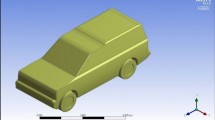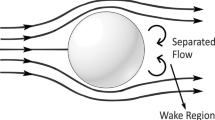Abstract
High pressure acting on the vehicle’s body plays an important role in deciding the aerodynamic drag. An idea has been suggested to enhance the aerodynamic performance for small passenger car by relieving the high pressure in the engine room. The high pressure inside the engine room can be released to the outside of the vehicle through a hole perforated on the wheel house liner. About 1 % of the drag coefficient can be improved with the 1.88 % of the radiator air mass flow rate increment by installing the top hole with slots on the wheel house liner. Flow simulations are performed at the driving velocity of 110 km/h with the moving wall condition of the same velocity. The tire is rotating to catch more precise flow physics around a tire and wheelhouse liner.
Similar content being viewed by others
Abbreviations
- A :
-
frontal projection area of car, m2
- C d :
-
drag coefficient
- Hh :
-
top hole height of wheel house liner, cm
- V ∞ :
-
free stream velocity, m/s
- Wh :
-
top hole width of wheel house liner, cm
- (C d)norm :
-
normalized drag coefficient
- (m Radiato)base :
-
radiator air mass flow rate of base model
- (m Radiato)simulation :
-
radiator air mass flow rate of modified simulation model
- Δm Radiator :
-
radiator air mass flow rate difference between the base model and modified simulation model
- ρ :
-
free stream air density, kg/m3
References
FLUENT (2015). Version 16 User Guide. Fluent Inc.
Fourrie, G., Keirsbulck, L., Labraga, L. and Gillieron, P. (2011). Bluff-body drag reduction using a deflector. Experiments in Fluids 50, 2, 385–395.
Han, H. W., Park, H. H., Kim, M. S., Ha, J. P. and Kim, Y. N. (2013). Aerodynamic performance dependency on the geometric shape and mounting location of OSRVM. Trans. Korean Society of Automotive Engineers 21, 3, 30–42.
Han, T. H., Mooney, K., Petropoulou, S. and Papper, J. (2016). Adjoint-driven aerodynamic shape optimization based on a combination of steady state and transient flow solutions. SAE Int. J. Passenger Cars -Mechanical Systems 9, 2, 695–709.
Jeong, S. M., Kim, T. K., Ahn, S. J., Choi, J. K., Kim, K. H. and Kim, K. W. (2013). Parametric study of vehicle shapes of ultra-low aerodynamic drag and vehicle shapes with aerodynamic drag reduction devices for aerodynamic drag reduction. Spring Conf. Proc., Korean Society of Automotive Engineers, 1559–1567.
Kim, D. R., Lee, H. and Choi, H. C. (2014). Drag reduction of a three-dimensional model vehicle using automatic moving deflector. KSME 2014 Fall Conf., 95–99.
Kim, H. L., Shin, J. S., Kim, H. J. and Kim, H. K. (2015). Development of active aero-devices on vehicle underbody for improvement in aerodynamic performance. Spring Conf. Proc., Korean Society of Automotive Engineers, 663–669.
Kim, J. M., Kim, K. M., Ha, S. J. and Kim, M. S. (2016). Grille design for passenger car to improve aerodynamic and cooling performance using cfd technique. Int. J. Automotive Technology 17, 6, 967–976.
Lee, D. H., Choi, S. Y. and Kim, Y. S. (2012). Separation fin applied on vehicle for aerodynamic performance improvement. KSAE Annual Conf. Proc., Korean Society of Automotive Engineers, 1899–1903.
Lee, K. I., Song, B. H., Ha, J. P. and Lee, T. W. (2010). Aerodynamic front end styling using the optimized opening for fuel efficiency improvement. Spring Conf. Proc., Korean Society of Automotive Engineers, 55–60.
Park, H. K. (2012). Variation of drag coefficient with the change of tail on hatch back style simple model. KSAE Annual Conf. Proc., Korean Society of Automotive Engineers, 1937–1943.
Salati, L., Cheli, F. and Schito, P. (2015). Heavy truck drag reduction obtained from devices installed on the trailer. SAE Int. J. Commercial Vehicles 8, 2, 747–760.
Sim, D. Y., Lee, S. H. and Kim, C. H. (2014). Development of induced drag reduction device (IDRD) for an aerodynamic drag reduction on a heavy-duty truck. KSAE Annual Conf. Proc., Korean Society of Automotive Engineers, 1001–1006.
Waltzer, S., Hawkins, J. and Mitcham, A. (2015). Wind tunnel evaluation of potential aerodynamic drag reductions from trailer aerodynamic component combinations. SAE Paper No. 2015-01-2884.
Wood, R. M. (2004). Impact of advanced aerodynamic technology on transportation energy consumption. SAE Paper No. 2004-01-1306.
Author information
Authors and Affiliations
Corresponding author
Rights and permissions
About this article
Cite this article
Ha, S.J., Chun, U., Park, J.Y. et al. Enhancement of aerodynamic performance through high pressure relief in the engine room for passenger car using cfd technique. Int.J Automot. Technol. 18, 779–784 (2017). https://doi.org/10.1007/s12239-017-0077-6
Received:
Revised:
Accepted:
Published:
Issue Date:
DOI: https://doi.org/10.1007/s12239-017-0077-6




